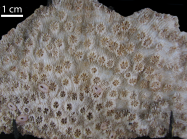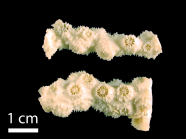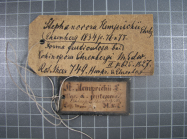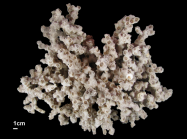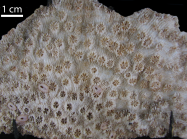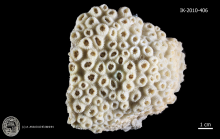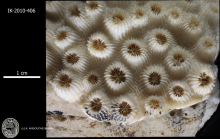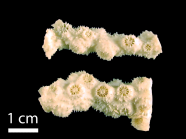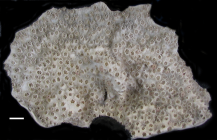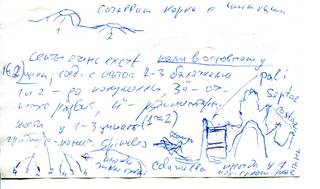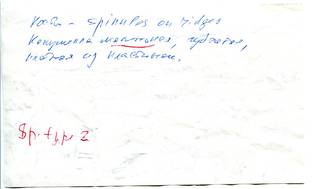WoRMS taxon details
Echinopora Lamarck, 1816
205519 (urn:lsid:marinespecies.org:taxname:205519)
accepted
Genus
Echinopora rosularia Lamarck, 1816 accepted as Echinopora lamellosa (Esper, 1791) (type by original designation)
Acanthelia Wells, 1937 · unaccepted > junior subjective synonym
Acanthopora Verrill, 1864 · unaccepted > junior subjective synonym
Astraea (Heliastraea) Milne Edwards & Haime, 1857 † · unaccepted > junior subjective synonym
Echinastrea De Blainville, 1830 · unaccepted > junior subjective synonym
Heliastraea Milne Edwards & Haime, 1857 · unaccepted > junior subjective synonym
Heliastraea (Heliastraea) Milne Edwards & Haime, 1857 † · unaccepted > junior subjective synonym
Heliastrea Milne Edwards & Haime, 1857 · unaccepted > junior subjective synonym
Stephanocora Ehrenberg, 1834 · unaccepted > junior subjective synonym
- Species Echinopora ashmorensis Veron, 1990
- Species Echinopora forskaliana (Milne Edwards & Haime, 1849)
- Species Echinopora fruticulosa (Ehrenberg, 1834)
- Species Echinopora gemmacea (Lamarck, 1816)
- Species Echinopora hirsutissima Milne Edwards & Haime, 1849
- Species Echinopora horrida Dana, 1846
- Species Echinopora irregularis Veron, Turak & DeVantier, 2000
- Species Echinopora lamellosa (Esper, 1791)
- Species Echinopora mammiformis (Nemenzo, 1959)
- Species Echinopora pacifica Veron, 1990
- Species Echinopora robusta Veron, 2000
- Species Echinopora taylorae (Veron, 2000)
- Species Echinopora tiranensis Veron, Turak & DeVantier, 2000
- Species Echinopora aspera (Ellis & Solander, 1786) accepted as Echinophyllia aspera (Ellis & Solander, 1786) (unaccepted > superseded combination)
- Species Echinopora carduus Klunzinger, 1879 accepted as Echinopora gemmacea (Lamarck, 1816) (unaccepted > junior subjective synonym)
- Species Echinopora concinna Verrill, 1901 accepted as Echinopora lamellosa (Esper, 1791) (unaccepted > junior subjective synonym)
- Species Echinopora ehrenbergi Milne Edwards & Haime, 1849 accepted as Echinopora gemmacea (Lamarck, 1816) (unaccepted > junior subjective synonym)
- Species Echinopora ehrenbergii Milne Edwards & Haime, 1849 accepted as Echinopora gemmacea (Lamarck, 1816) (unaccepted > junior subjective synonym, misspelling)
- Species Echinopora elegans Verrill, 1901 accepted as Echinopora lamellosa (Esper, 1791) (unaccepted > junior subjective synonym)
- Species Echinopora flexuosa Verrill, 1864 accepted as Echinopora lamellosa (Esper, 1791) (unaccepted > junior subjective synonym)
- Species Echinopora franksi Gregory, 1895 accepted as Orbicella franksi (Gregory, 1895) (unaccepted > superseded combination, basionym)
- Species Echinopora glabra Chevalier, 1975 accepted as Echinopora mammiformis (Nemenzo, 1959) (unaccepted > junior subjective synonym)
- Species Echinopora grandicula Claereboudt, 2006 (unaccepted > nomen nudum)
- Species Echinopora helli Rousseau, 1854 accepted as Echinopora hirsutissima Milne Edwards & Haime, 1849 (unaccepted > junior subjective synonym)
- Species Echinopora hemprichi (Ehrenberg, 1834) accepted as Echinopora gemmacea (Lamarck, 1816) (unaccepted > junior subjective synonym)
- Species Echinopora litae Nemenzo & Montecillo, 1981 accepted as Echinopora lamellosa (Esper, 1791) (unaccepted > junior subjective synonym)
- Species Echinopora magna Gardiner, 1904 accepted as Echinophyllia aspera (Ellis & Solander, 1786) (unaccepted > junior subjective synonym)
- Species Echinopora pacificus Veron, 1990 accepted as Echinopora pacifica Veron, 1990 (unaccepted > incorrect grammatical agreement of specific epithet)
- Species Echinopora reflexa Dana, 1846 accepted as Echinopora lamellosa (Esper, 1791) (unaccepted > junior subjective synonym)
- Species Echinopora rosularia Lamarck, 1816 accepted as Echinopora lamellosa (Esper, 1791) (unaccepted > junior subjective synonym)
- Species Echinopora rousseaui Milne Edwards & Haime, 1849 accepted as Echinopora gemmacea (Lamarck, 1816) (unaccepted > junior subjective synonym)
- Species Echinopora solidior Gardiner, 1904 accepted as Echinopora hirsutissima Milne Edwards & Haime, 1849 (unaccepted > junior subjective synonym)
- Species Echinopora solidior Milne Edwards & Haime, 1849 accepted as Echinopora gemmacea (Lamarck, 1816) (unaccepted > junior subjective synonym)
- Species Echinopora striatula Studer, 1878 accepted as Echinopora lamellosa (Esper, 1791) (unaccepted > junior subjective synonym)
- Species Echinopora tertia Gardiner, 1904 accepted as Echinopora hirsutissima Milne Edwards & Haime, 1849 (unaccepted > junior subjective synonym)
- Species Echinopora undulata Dana, 1846 accepted as Echinopora lamellosa (Esper, 1791) (unaccepted > junior subjective synonym)
- Species Echinopora concamerata (Forskål, 1775) (uncertain > taxon inquirendum, synonym)
- Species Echinopora pellucida Rehberg, 1892 (uncertain > taxon inquirendum)
- Species Echinopora ringens (Lamarck, 1816) (uncertain > taxon inquirendum)
- Species Echinopora spinulosa Brüggemann, 1879 (uncertain > taxon inquirendum)
marine, fresh, terrestrial
recent + fossil
Lamarck, J.-B. M. de. (1816). Histoire naturelle des animaux sans vertèbres. Tome second. <em>Paris. Verdière.</em> Vol. 2 pp. 1-568., available online at http://www.biodiversitylibrary.org/item/47698 [details] 
Description 'Polypier pierreux, fixé, aplati et étendu en membrane libre, arrondie, foliiforme, finement striée des deux côtés. La...
Description Colonies are massive, arborescent or foliaceous or mixtures of these forms. Corallites are plocoid with calices up to 5 mm...
Description 'Polypier pierreux, fixé, aplati et étendu en membrane libre, arrondie, foliiforme, finement striée des deux côtés. La surface supérieure chargée de petites papilles, et, en outre, d'orbicules rosacés, convexes, très-hérissés de papilles, percés d'un ou deux trous, recouvrant chacun une étoile lamelleuse. Étoiles éparses, orbiculaires, couvertes; à lames inégales, presque confuses, saillantes des parois et du fond, et obstruant en partie la cavité.' (Lamarck, 1816: 252) [details]
Description Colonies are massive, arborescent or foliaceous or mixtures of these forms. Corallites are plocoid with calices up to 5 mm...
Description Colonies are massive, arborescent or foliaceous or mixtures of these forms. Corallites are plocoid with calices up to 5 mm in diameter. Septa are exsert and irregular. Columellae are usually prominent. Costae are usually restricted to the corallite wall. The coenosteum is granulated (except E. mammiformis). Polyps are extended only at night (Veron, 1986 <57>). [details]
Hoeksema, B. W.; Cairns, S. (2024). World List of Scleractinia. Echinopora Lamarck, 1816. Accessed through: World Register of Marine Species at: https://www.marinespecies.org/aphia.php?p=taxdetails&id=205519 on 2024-04-16
Date
action
by
![]() The webpage text is licensed under a Creative Commons Attribution 4.0 License
The webpage text is licensed under a Creative Commons Attribution 4.0 License
original description
Lamarck, J.-B. M. de. (1816). Histoire naturelle des animaux sans vertèbres. Tome second. <em>Paris. Verdière.</em> Vol. 2 pp. 1-568., available online at http://www.biodiversitylibrary.org/item/47698 [details] 
original description (of Acanthelia Wells, 1937) Wells JW. (1937). New genera of Mesozoic and Cenozoic corals. <em>Journal of Paleontology.</em> 11: 73-77. [details]
original description (of Heliastrea Milne Edwards & Haime, 1857) Milne Edwards H, Haime J. (1857). Histoire naturelle des coralliaires ou polypes proprement dits 2. Librairie Encyclopédique de Roret, Paris. 631 pp., available online at https://www.biodiversitylibrary.org/page/12403706 [details]
original description (of Echinastrea De Blainville, 1830) Blainville, D. de. (1816-1830). Dictionnaire des Sciences naturelles. <em>Art. Planaire in Tom. 41. Paris 1826. p. 204-218. Art. Vers in Tom. 57. Paris 1828. p 530, 577-579. Planches, 2 partie: Règne organisé, Zoologie, Vers et Zoophytes. Paris 1816 to 1830. tab 40.</em> [details]
original description (of Stephanocora Ehrenberg, 1834) Ehrenberg, C. G. (1834). Beiträge zur physiologischen Kenntniss der Corallenthiere im allgemeinen, und besonders des rothen Meeres, nebst einem Versuche zur physiologischen Systematik derselben. <em>Abhandlungen der Königlichen Akademie der Wissenschaften, Berlin.</em> 1: 225-380., available online at https://www.biodiversitylibrary.org/page/29725862 [details]
original description (of Acanthopora Verrill, 1864) Verrill, A. E. (1864). List of the polyps and corals sent by the Museum of Comparative Zoology to other institutions in exchange, with annotations. <em>Bulletin of the Museum of Comparative Zoology.</em> 1: 29-60., available online at https://www.biodiversitylibrary.org/page/6587563 [details]
original description (of Heliastraea Milne Edwards & Haime, 1857) Milne Edwards H, Haime J. (1857). Histoire naturelle des coralliaires ou polypes proprement dits 2. Librairie Encyclopédique de Roret, Paris. 631 pp., available online at https://www.biodiversitylibrary.org/page/12403706 [details]
basis of record Veron JEN. (1986). Corals of Australia and the Indo-Pacific. <em>Angus & Robertson Publishers.</em> [details]
additional source Veron JEN, Pichon M, Wijsman-Best M. (1977). Scleractinia of Eastern Australia – Part II. Families Faviidae, Trachyphylliidae. <em>Australian Institute of Marine Science Monograph series.</em> 3: 1-233. [details]
additional source Robertson R. (1970). Review of the predators and parasites of stony Corals, with special reference to symbiotic Prosobranch Gastropods. <i>Pacific Science 24 (1)</i>: 43-54
page(s): 48 [details]
additional source Veron JEN. (2000). Corals of the World. Vol. 1–3. <em>Australian Institute of Marine Science and CRR, Queensland, Australia.</em> [details]
additional source Budd AF, Fukami H, Smith ND, Knowlton N. (2012). Taxonomic classification of the reef coral family Mussidae (Cnidaria: Anthozoa: Scleractinia). <em>Zoological Journal of the Linnean Society.</em> 166 (3): 465-529., available online at https://doi.org/10.1111/j.1096-3642.2012.00855.x [details]
additional source Matthai G. (1914). A revision of the recent colonial Astraeidae possessing distinct corallites. <em>Transactions of the Linnean Society of London, 2nd Series Zoology.</em> 17(1): 1-140, pls. 1-38. [details]
additional source Cairns, S.D., R. Baron-Szabo, A.F. Budd, B. Lathuilière, E. Roniewicz, J. Stolarski & K.G. Johnson. (2010). Corallosphere. , available online at http://www.corallosphere.org [details]
additional source Huang D, Benzoni F, Fukami H, Knowlton N, Smith ND, Budd AF (2014) Taxonomic classification of the reef coral families Merulinidae, Montastraeidae, and Diploastraeidae (Cnidaria: Anthozoa: Scleractinia). Zoological Journal of the Linnean Society 171: 277–355. [details]
additional source Duncan PM (1884) A revision of the families and genera of the sclerodermic Zoantharia, Ed. & H., or Madreporaria (M. Rugosa excepted). Journal of the Linnean Society of London, 18: 1-204. [details]
additional source Veron JEN, Marsh LM. (1988). Hermatypic corals of Western Australia : records and annotated species list. <em>Records Western Australian Museum Supplement.</em> 29: 1-136., available online at https://doi.org/10.5962/bhl.title.60555
page(s): 28, 116 [details]
additional source Khalil HM, Fathy MS, Al Sawy SM. (2021). Quaternary corals (Scleractinia: Merulinidae) from the Egyptian and Saudi Arabian Red Sea Coast. <em>Geological Journal.</em> , available online at https://onlinelibrary.wiley.com/doi/10.1002/gj.4145?af=R [details]
additional source Reinicke, G. B.; Schuhmacher, H. (1996). Significance of different traits of soft-coral assemblages (Octocorallia, Alcyoniina) in benthic reef communities of the Red Sea. Göttinger Arbeiten zur Geologie Paläontologie, Sb2, 77-84
page(s): 82 [details]
original description (of Acanthelia Wells, 1937) Wells JW. (1937). New genera of Mesozoic and Cenozoic corals. <em>Journal of Paleontology.</em> 11: 73-77. [details]
original description (of Heliastrea Milne Edwards & Haime, 1857) Milne Edwards H, Haime J. (1857). Histoire naturelle des coralliaires ou polypes proprement dits 2. Librairie Encyclopédique de Roret, Paris. 631 pp., available online at https://www.biodiversitylibrary.org/page/12403706 [details]
original description (of Echinastrea De Blainville, 1830) Blainville, D. de. (1816-1830). Dictionnaire des Sciences naturelles. <em>Art. Planaire in Tom. 41. Paris 1826. p. 204-218. Art. Vers in Tom. 57. Paris 1828. p 530, 577-579. Planches, 2 partie: Règne organisé, Zoologie, Vers et Zoophytes. Paris 1816 to 1830. tab 40.</em> [details]
original description (of Stephanocora Ehrenberg, 1834) Ehrenberg, C. G. (1834). Beiträge zur physiologischen Kenntniss der Corallenthiere im allgemeinen, und besonders des rothen Meeres, nebst einem Versuche zur physiologischen Systematik derselben. <em>Abhandlungen der Königlichen Akademie der Wissenschaften, Berlin.</em> 1: 225-380., available online at https://www.biodiversitylibrary.org/page/29725862 [details]
original description (of Acanthopora Verrill, 1864) Verrill, A. E. (1864). List of the polyps and corals sent by the Museum of Comparative Zoology to other institutions in exchange, with annotations. <em>Bulletin of the Museum of Comparative Zoology.</em> 1: 29-60., available online at https://www.biodiversitylibrary.org/page/6587563 [details]
original description (of Heliastraea Milne Edwards & Haime, 1857) Milne Edwards H, Haime J. (1857). Histoire naturelle des coralliaires ou polypes proprement dits 2. Librairie Encyclopédique de Roret, Paris. 631 pp., available online at https://www.biodiversitylibrary.org/page/12403706 [details]
basis of record Veron JEN. (1986). Corals of Australia and the Indo-Pacific. <em>Angus & Robertson Publishers.</em> [details]
additional source Veron JEN, Pichon M, Wijsman-Best M. (1977). Scleractinia of Eastern Australia – Part II. Families Faviidae, Trachyphylliidae. <em>Australian Institute of Marine Science Monograph series.</em> 3: 1-233. [details]
additional source Robertson R. (1970). Review of the predators and parasites of stony Corals, with special reference to symbiotic Prosobranch Gastropods. <i>Pacific Science 24 (1)</i>: 43-54
page(s): 48 [details]
additional source Veron JEN. (2000). Corals of the World. Vol. 1–3. <em>Australian Institute of Marine Science and CRR, Queensland, Australia.</em> [details]
additional source Budd AF, Fukami H, Smith ND, Knowlton N. (2012). Taxonomic classification of the reef coral family Mussidae (Cnidaria: Anthozoa: Scleractinia). <em>Zoological Journal of the Linnean Society.</em> 166 (3): 465-529., available online at https://doi.org/10.1111/j.1096-3642.2012.00855.x [details]
additional source Matthai G. (1914). A revision of the recent colonial Astraeidae possessing distinct corallites. <em>Transactions of the Linnean Society of London, 2nd Series Zoology.</em> 17(1): 1-140, pls. 1-38. [details]
additional source Cairns, S.D., R. Baron-Szabo, A.F. Budd, B. Lathuilière, E. Roniewicz, J. Stolarski & K.G. Johnson. (2010). Corallosphere. , available online at http://www.corallosphere.org [details]
additional source Huang D, Benzoni F, Fukami H, Knowlton N, Smith ND, Budd AF (2014) Taxonomic classification of the reef coral families Merulinidae, Montastraeidae, and Diploastraeidae (Cnidaria: Anthozoa: Scleractinia). Zoological Journal of the Linnean Society 171: 277–355. [details]
additional source Duncan PM (1884) A revision of the families and genera of the sclerodermic Zoantharia, Ed. & H., or Madreporaria (M. Rugosa excepted). Journal of the Linnean Society of London, 18: 1-204. [details]
additional source Veron JEN, Marsh LM. (1988). Hermatypic corals of Western Australia : records and annotated species list. <em>Records Western Australian Museum Supplement.</em> 29: 1-136., available online at https://doi.org/10.5962/bhl.title.60555
page(s): 28, 116 [details]
additional source Khalil HM, Fathy MS, Al Sawy SM. (2021). Quaternary corals (Scleractinia: Merulinidae) from the Egyptian and Saudi Arabian Red Sea Coast. <em>Geological Journal.</em> , available online at https://onlinelibrary.wiley.com/doi/10.1002/gj.4145?af=R [details]
additional source Reinicke, G. B.; Schuhmacher, H. (1996). Significance of different traits of soft-coral assemblages (Octocorallia, Alcyoniina) in benthic reef communities of the Red Sea. Göttinger Arbeiten zur Geologie Paläontologie, Sb2, 77-84
page(s): 82 [details]
 Present
Present  Inaccurate
Inaccurate  Introduced: alien
Introduced: alien  Containing type locality
Containing type locality
Nontype WAM 247-74, geounit Australian Exclusive Economic Zone [details]
Nontype WAM 557-86, geounit Ashmore-Cartier Is. [details]
Nontype WAM 575-86, geounit Ashmore-Cartier Is. [details]
Nontype WAM 596-86, geounit Ashmore-Cartier Is. [details]
From editor or global species database
Comparison This genus is one of the most distinct and well-defined genera in Merulinidae. Synapomorphies inferred are large columellae, extensive coenosteum and weak abortive septa. The latter two features distinguish Echinopora from the closely-related genera of Cyphastrea, Paramontastraea and Orbicella. Large columella is only shared with Orbicella among all Merulinidae taxa. Data is available only for six of the 13 species; the genus requires substantial additional sampling, particularly for the recently-described species. None of the species described in Veron (2000) has been placed on the phylogeny. [details]Description 'Polypier pierreux, fixé, aplati et étendu en membrane libre, arrondie, foliiforme, finement striée des deux côtés. La surface supérieure chargée de petites papilles, et, en outre, d'orbicules rosacés, convexes, très-hérissés de papilles, percés d'un ou deux trous, recouvrant chacun une étoile lamelleuse. Étoiles éparses, orbiculaires, couvertes; à lames inégales, presque confuses, saillantes des parois et du fond, et obstruant en partie la cavité.' (Lamarck, 1816: 252) [details]
Diagnosis Colonial, with extracalicular budding only. Corallites monomorphic and discrete (1–3 centers); monticules absent. Coenosteum generally spinose (costate in E. mammiformis), extensive amount (≥ corallite diameter). Generally, calice width medium (4–15 mm), with low relief (< 3 mm). Costosepta not confluent. Septa in 3 cycles (24–36 septa). Free septa regular. Septa spaced >11 septa per 5 mm. Costosepta unequal in relative thickness. Columellae trabecular and spongy (> 3 threads), ≥ 1/4 of calice width, and discontinuous among adjacent corallites. Paliform (uniaxial) lobes weak or moderate. Epitheca well developed and endotheca low-moderate (tabular). Tooth base at mid-calice circular. Tooth tip at mid-calice irregular; tip orientation multiaxial. Tooth height low (< 0.3 mm) and tooth spacing medium (0.3–1 mm), with > 6 teeth per septum. Granules scattered on septal face; irregular in shape. Interarea smooth. Walls formed by partial septotheca; abortive septa weak. Thickening deposits fibrous. Costa center clusters weak; 0.3–0.6 mm between clusters; medial lines weak. Septum center clusters weak; < 0.3 mm between clusters; medial lines weak. Transverse crosses absent. Columella centers clustered. [details]
Remark Echinopora Lamarck, 1816: 252 is a relatively large genus, with four new species only recently described (Veron, 2000). It was first described as having an upper surface filled with small papillae—'la surface supérieure chargée de petites papilles' (Lamarck, 1816: 252)—a plesiomorphic trait shared with Cyphastrea. Together with Paramontastraea and Orbicella, these taxa have been consistently recovered at the base of the tree, either as paraphyletic (Huang et al., 2011; Huang, 2012), or as a sister clade to the rest of Merulinidae (Arrigoni et al., 2012). The latter hypothesis appears to be more well supported with molecular data, and it also corresponds to the morphological tree topology obtained here. It should be noted that the type species of Echinopora is E. rosularia Lamarck, 1816: 253, which has been synonymized as E. lamellosa (Esper, 1795: 65; Ranson, 1943: 118). The latter's holotype is lost (Chevalier, 1975: 70; Scheer, 1990: 398), but Lamarck's holotype of E. rosularia (MNHN IK-2010-635) should still be considered the type for this genus. [details]
From other sources
Description Colonies are massive, arborescent or foliaceous or mixtures of these forms. Corallites are plocoid with calices up to 5 mm in diameter. Septa are exsert and irregular. Columellae are usually prominent. Costae are usually restricted to the corallite wall. The coenosteum is granulated (except E. mammiformis). Polyps are extended only at night (Veron, 1986 <57>). [details]Remark Type species: Echinopora rosularia Lamarck, 1816 from the "Indian Ocean" (Veron, 1986). [details]
